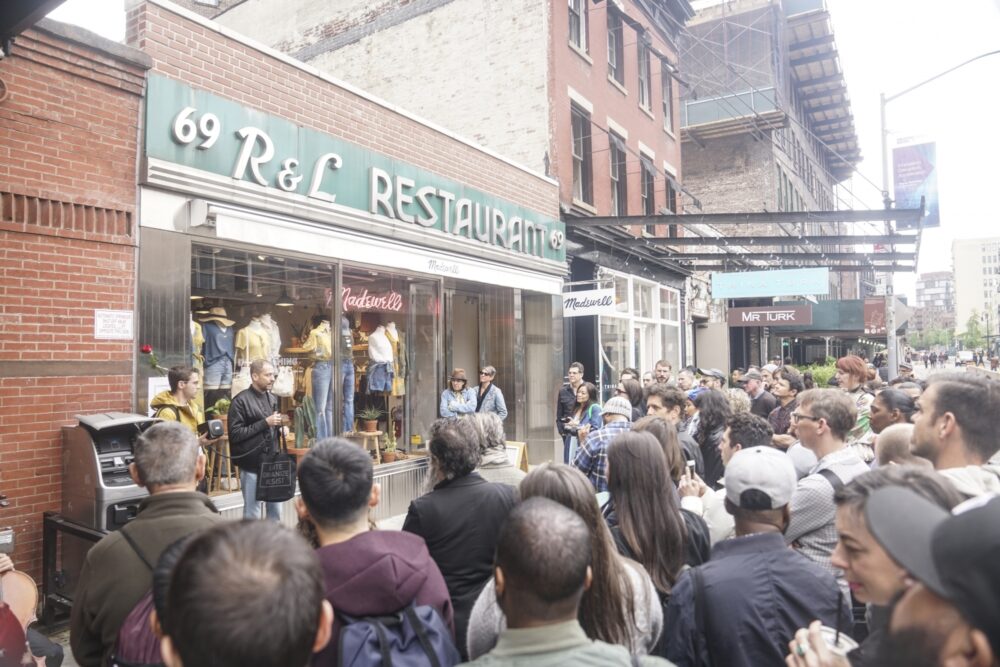For the 6th Annual Last Address Tribute Walk, Visual AIDS Programs Director Alex Fialho led a tribute walk to the Lost Addresses of six sites marked by cultural and activist HIV and AIDS histories in the West Village: Florent, The Mineshaft, The Clit Club, the Piers, The Neutral Zone, and St Vincent’s Hospital. Visiting former sites of nightlife, housing, creativity and care, the 6th Annual Last Address Tribute Walk shifted from previous iterations highlighting home addresses to locate community and social life in the midst of the AIDS crisis.
The program began at 3PM with a screening of Ira Sachs’ film Last Address (2010, 9 min.) at the Whitney Museum of American Art, followed by short video clips contextualizing each site, including Charles Atlas’ Butcher’s Vogue (1991, shot at Florent), a slideshow created by Julie Tolentino of Clit Club invitations, and footage of Sylvia Rivera reflecting about her life on the Piers from the documentary Fenced Out (2000, produced by FIERCE, Paper Tiger Television, and the Neutral Zone). The event then moved to the streets of the West Village, stopping at each address for tributes by special guests involved with or influenced by the former sites: Stuart Comer at Florent (69 Gansevoort Street); Brad Gooch at The Mineshaft (835 Washington Street); Vivian Crockett, Tara Hart, Michele Hill and Lori E. Seid with words by Julie Tolentino at the Clit Club (432 W 14th Street); Egyptt LaBeija at the Piers (at Pier 48); Luna Luis Ortiz at The Neutral Zone (162 Christopher Street); and Rafael Sánchez with Joel Handorff at St Vincent’s Hospital (15 7th Avenue). At each site, a drawing by Win Mixter evoking the Lost Addresses and a rose were left in tribute.
Watch all six reflections here:
“This was not just a place that people went to eat. This was not a monoculture—everyone came here. You would be sitting cheek to jell with meatpacking workers, drag queens, and artists. It really was a microcosm of New York.” — Stuart Comer on Florent
“The two story dream box full of floor hatches and shoe shine stands, torture devices and pillories out of puritan Salem also had an extraordinarily dark, luscious glamour. A cosmopolitan dandyism that must have rivaled the Hellfire Club of 18th century London.” — Brad Gooch on the Mineshaft
“In the earliest days, our club was a mixed party and ultimately as we look back at this time, it was a space that offered until then a never to be repeated legacy, that is also called a convergence, a party, an identity, a home base, a performance, a club gathering, a lifeblood. Our grassroots intersectional efforts emerged inside these two floors.“ — Julie Tolentino and the Clit Club Crew on the Clit Club
“To see this whole village transform into what it is now is taking away the history of what this village was and should always be. The village is for us, and the gentrification has taken away all of the history of the struggle the LGBT community had to go through. Sometimes I cry when I come down here and look at what they have done. In the news when they talk about the village they do not talk about us in a good way, only what is wrong with us, not the true history of where we came from and what we have gone through.” — Egyptt LaBeija on the Piers
“When it closed we were devastated because it was another place we felt we could go and be young, and loud, and have a good time and be safe, which is the number one thing. Again a lot of us were homeless at the time so it was just a warm place, especially in the winter.” — Luna Luis Ortiz on the Neutral Zone
"T’is for the song once left behind,
In recesses of the mind,
That candles yet remind,
What youth flowered once though,
Now remains to serve the plough" — Rafael Sánchez on St. Vincent's Hospital

